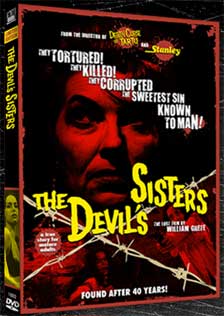 THE
DEVIL’S SISTERS (1966)
THE
DEVIL’S SISTERS (1966)Director: William Grefé
Ballyhoo Motion Pictures
 THE
DEVIL’S SISTERS (1966)
THE
DEVIL’S SISTERS (1966)Floridian filmmaker William Grefé’s previously lost “true crime” roughie THE DEVIL’S SISTERS makes its digital debut (well, most of it) via special features producer Ballyhoo Motion Pictures.
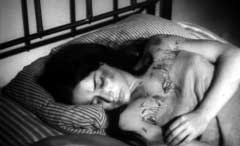
When her policeman boyfriend Antonio (Frank Pinero, Grefé’s DEATH CURSE OF TARTU) dumps her for spurning his more physical advances, virginal Teresa (Sharon Saxon) decides to go to Tijuana and look for a job. She answers a newspaper ad seeking an attractive young woman to help with “extensive domestic and social activities” and soon finds herself locked in a bedroom cell and forced to service the paying customers of hostess Rita Alvarado (Anita Crystal). Teresa seeks solace in alcohol and cigarettes until Antonio turns up as a paying customer, calls her a “money-hungry whore” and refuses to help her. Rita’s ever-watchful henchman Jose (William Marcos) informs her that the policeman recognized Teresa, so the girl is spirited away to “The Ranch” where Rita’s sister Carmen (Floridian TV actress Velia Martinez) sells girls to the highest bidder while her cigar-chomping henchwoman Marta (Mildred Rodesky) “treats” the girls who have had the misfortune to get pregnant and meats out punishment to those who try to escape. When Teresa and Emilia (Nora Alonzo, Grefé’s WILD REBELS) fail to fetch 500 pesos from an “Englishman” (Michael DeBeausset, the Florida-shot HONEYMOON OF HORROR) and Emilia is killed trying to escape, Teresa’s survival becomes less certain (her own escape attempt is punished with a barbed wire-wrapped nap on “The Royal Marriage Bed”). Will Teresa escape “The Ranch” or will she be digging her own grave next?
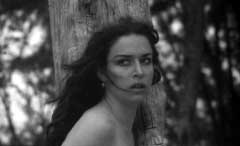 For
the answer to that cliffhanger of a question, you’ll have to ask director
William Grefé since the seemingly only extant print of THE DEVIL’S
SISTERS is lacking its final eight minute reel. In his optional introduction
to the film (2:39), Grefé informs us that he did not have the funds to
buy his own personal print of the film (only 35 prints were apparently struck).
Years later, Grefé attempted to track down a print of the film without
success. In the internet era, he was able to find one from a German collector;
however, it was missing the final reel which accounted for roughly eight minutes.
As such, the film cuts off in the middle of a suspenseful woodland chase. At
this point, Grefé appears on-camera and explains how the film ends with
the assistance of some new animated storyboards. The climax apparently included
quite a bit of bloodshed including a police shootout and a final bit of retribution
that would recur in a number of later women-in-prison films (including one or
two of the ILSA entries, although it was probably inspired by the climax of
one of Joseph P. Mawra’s OLGA films). Indeed, the second half of the film
set at “The Ranch” feels like a proto-WIP film since the girls are
not pressed into service but merely confined and tortured. The first half of
the film, on the other hand, feels a bit like one of Joseph Sarno’s cheaper
films as it is mostly confined to one set and at least attempts to render the
protagonist’s mental state visually with much artfully-framed –
and occasionally chiaroscuro-lit – writhing set to Al Jacob’s non-stop
monotonous Spanish guitar accompaniment but Saxon’s (or some voice artist’s)
enervating accented narration grates on the nerves. There’s very little
actual skin on display, but the tussling during the covered rape scenes and
the implied brutality of the stone-faced sadists (as well as some pre-NIGHT
OF THE LIVING DEAD inky splashes of chocolate syrup blood) are pretty strong
stuff for the mid-1960s (particularly for a regional production). Saxon –
in her introductory (and only) credited performance – is unmemorable from
the start; it certainly doesn’t help that most of her dialogue is narration
due to the flashback structure but she is well-exploited (no pun intended) by
Grefé mainstay Julio C. Chávez’s camera. Of the two sisters,
Carmen is not only the more interesting one but actress Martinez is the better
actress and is thankfully given more to work with. Marcos is the only other
actor who makes much of an impression (none of the other cast members are bad,
just suitably functional).
For
the answer to that cliffhanger of a question, you’ll have to ask director
William Grefé since the seemingly only extant print of THE DEVIL’S
SISTERS is lacking its final eight minute reel. In his optional introduction
to the film (2:39), Grefé informs us that he did not have the funds to
buy his own personal print of the film (only 35 prints were apparently struck).
Years later, Grefé attempted to track down a print of the film without
success. In the internet era, he was able to find one from a German collector;
however, it was missing the final reel which accounted for roughly eight minutes.
As such, the film cuts off in the middle of a suspenseful woodland chase. At
this point, Grefé appears on-camera and explains how the film ends with
the assistance of some new animated storyboards. The climax apparently included
quite a bit of bloodshed including a police shootout and a final bit of retribution
that would recur in a number of later women-in-prison films (including one or
two of the ILSA entries, although it was probably inspired by the climax of
one of Joseph P. Mawra’s OLGA films). Indeed, the second half of the film
set at “The Ranch” feels like a proto-WIP film since the girls are
not pressed into service but merely confined and tortured. The first half of
the film, on the other hand, feels a bit like one of Joseph Sarno’s cheaper
films as it is mostly confined to one set and at least attempts to render the
protagonist’s mental state visually with much artfully-framed –
and occasionally chiaroscuro-lit – writhing set to Al Jacob’s non-stop
monotonous Spanish guitar accompaniment but Saxon’s (or some voice artist’s)
enervating accented narration grates on the nerves. There’s very little
actual skin on display, but the tussling during the covered rape scenes and
the implied brutality of the stone-faced sadists (as well as some pre-NIGHT
OF THE LIVING DEAD inky splashes of chocolate syrup blood) are pretty strong
stuff for the mid-1960s (particularly for a regional production). Saxon –
in her introductory (and only) credited performance – is unmemorable from
the start; it certainly doesn’t help that most of her dialogue is narration
due to the flashback structure but she is well-exploited (no pun intended) by
Grefé mainstay Julio C. Chávez’s camera. Of the two sisters,
Carmen is not only the more interesting one but actress Martinez is the better
actress and is thankfully given more to work with. Marcos is the only other
actor who makes much of an impression (none of the other cast members are bad,
just suitably functional).
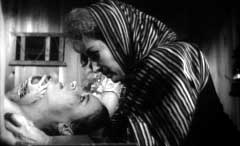
Ballyhoo Motion Pictures has released THE DEVIL’S SISTERS on a single-layer DVD-R (sold exclusively through Grefé’s own Reality Edge Films). The progressive anamorphic widescreen (1.64:1) transfer is generally attractive with the nour-ish photography tending towards inky blacks and slightly greyish whites (not unlike some of the better Something Weird Video/Image Entertainment transfers of films of this era and genre). There are infrequent scratches and the element wavers at the one hour mark for about three to four minutes causing the image to almost pulse in and out of focus but not distractingly so; but it would be pointless to quibble over the imperfections considering that this may indeed be the only print source left in existence (the last eight minutes of which may be lost for good). Dialogue is always clear, but the Dolby Digital 2.0 mono audio fares best during the musical passages where the faint hiss is less noticeable. The menus are attractive and the authoring is problem-free with some nice transitional effects between menu screens.
 In
addition to the introduction and the summation of the missing footage at the
end – as well as an on-camera interview (see below) – Grefé
provides an audio commentary, and this is the least impressive of the extras.
He is still amazed that he was able to shoot the film in ten days and mentions
that it is his only black and white film (at the time, black and white stocks
were significantly faster than color stock) as well as the only one he shot
in a studio. He is rather unspecific about the prior and later credits of his
cast members (Marcos apparently went on to bigger parts in Hollywood, but presumably
under another name) and starts several tangential anecdotes before deciding
to get back to commenting on the current film (I have not heard them, but Grefé
has also provided commentaries for Something Weird Video/Image’s double
bills of STING OF DEATH/DEATH CURSE OF TARTU and THE HOOKED GENERATION/THE PSYCHEDELIC
PRIEST, as well as the BCI DVD of STANLEY [and it’s Code Red reissue]).
The more succinct on-camera interview “THE DEVIL’S SISTERS Revisited”
(9:17) in which the director describes how he took the treatment by John Nicholas
to theater owners Joseph Fink and Juan Hidalgo-Gato – for whom he had
already done STING OF DEATH and DEATH CURSE OF TARTU – and then wrote
the screenplay himself. He describes how easy it was to recreate Mexico in Davie,
Florida because of the influx of Cuban talent fleeing Castro’s regime.
He also describes how he bypassed the issue of shooting with a non-reflex 35mm
camera (requiring a different viewfinder for each lens) by shooting most of
the film with a 30mm lens which gave good depth of field and width in long shots
without distorting human faces in close-up. Since the production lacked squibs,
Grefé himself replaced the cameraman during the climactic gun-battle
as the weapons handler shot real bullets into the dirt and trees to give an
impression of impact lacking in the shots of the actors supposedly taking bullet
hits (although this is all lost to us now). Although the film was a nightmare
on the technical front, the director is only dissatisfied with the score (composer
Jacobs was presumably chosen by the producers since the only Grefé films
he scored were those produced by Fink and Hidalgo-Gato including the later THE
WILD REBELS).
In
addition to the introduction and the summation of the missing footage at the
end – as well as an on-camera interview (see below) – Grefé
provides an audio commentary, and this is the least impressive of the extras.
He is still amazed that he was able to shoot the film in ten days and mentions
that it is his only black and white film (at the time, black and white stocks
were significantly faster than color stock) as well as the only one he shot
in a studio. He is rather unspecific about the prior and later credits of his
cast members (Marcos apparently went on to bigger parts in Hollywood, but presumably
under another name) and starts several tangential anecdotes before deciding
to get back to commenting on the current film (I have not heard them, but Grefé
has also provided commentaries for Something Weird Video/Image’s double
bills of STING OF DEATH/DEATH CURSE OF TARTU and THE HOOKED GENERATION/THE PSYCHEDELIC
PRIEST, as well as the BCI DVD of STANLEY [and it’s Code Red reissue]).
The more succinct on-camera interview “THE DEVIL’S SISTERS Revisited”
(9:17) in which the director describes how he took the treatment by John Nicholas
to theater owners Joseph Fink and Juan Hidalgo-Gato – for whom he had
already done STING OF DEATH and DEATH CURSE OF TARTU – and then wrote
the screenplay himself. He describes how easy it was to recreate Mexico in Davie,
Florida because of the influx of Cuban talent fleeing Castro’s regime.
He also describes how he bypassed the issue of shooting with a non-reflex 35mm
camera (requiring a different viewfinder for each lens) by shooting most of
the film with a 30mm lens which gave good depth of field and width in long shots
without distorting human faces in close-up. Since the production lacked squibs,
Grefé himself replaced the cameraman during the climactic gun-battle
as the weapons handler shot real bullets into the dirt and trees to give an
impression of impact lacking in the shots of the actors supposedly taking bullet
hits (although this is all lost to us now). Although the film was a nightmare
on the technical front, the director is only dissatisfied with the score (composer
Jacobs was presumably chosen by the producers since the only Grefé films
he scored were those produced by Fink and Hidalgo-Gato including the later THE
WILD REBELS).
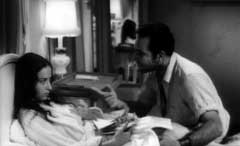 No
trailers for the film appear to exist anymore, but Ballyhoo has included a radio-spot
(0:12) for its reissue version titled SISTERS OF THE DEVIL, which attempts to
mislead the audience into thinking it’s a horror flick with the narration
“If you prayed for ROSEMARY’S BABY, pray for the girl in…”
(the reissue and this advertising campaign was the work of Florida distributor
K. Gordon Murray, who is best known to cult film fans for importing and dubbing
Mexican horror films like THE BRAINIAC, ROBOT MAN VS THE AZTEC MUMMY and THE
VAMPIRE among others). The still gallery is not just interesting but crucial
as it includes a number of stills from lost finale along with a couple US posters
as well as a German one with a title that translates roughly as “Slave
Sisters of Eroticism”. “Temple of Schlock” blogger –
and fellow DVD Drive-In contributor – Chris Poggiali’s essay “THE
DEVIL’S SISTERS: Endangered No More” is presented as a series of
text screens rather than an insert booklet. Poggiali first interviewed Grefé
about the elusive film in the 1990s and was told that he had been trying to
locate the negative or a decent print of the film for some time. Poggiali also
mentions the identity of the real-life sisters who inspired the film and the
existence of another film about the case (1976’s LAS POQUIANCHIS) as well
as a 1977 book by Jorge Ibargüengoitia. He likens the barbed-wire torture
scene to a scene from one of the OLGA films, but couches the film among various
late-1960s “true crime” films like IN COLD BLOOD and THE HONEYMOON
KILLERS. The essay is entertaining and the yellow on black text is nicely readable;
however, the screens only offer an option to advance to the next page but not
backwards. Trailers for STING OF DEATH and THE DEATH CURSE OF TARTU are also
included (it’s a pity they didn’t give us a William Grefé
trailer reel. (Eric
Cotenas)
No
trailers for the film appear to exist anymore, but Ballyhoo has included a radio-spot
(0:12) for its reissue version titled SISTERS OF THE DEVIL, which attempts to
mislead the audience into thinking it’s a horror flick with the narration
“If you prayed for ROSEMARY’S BABY, pray for the girl in…”
(the reissue and this advertising campaign was the work of Florida distributor
K. Gordon Murray, who is best known to cult film fans for importing and dubbing
Mexican horror films like THE BRAINIAC, ROBOT MAN VS THE AZTEC MUMMY and THE
VAMPIRE among others). The still gallery is not just interesting but crucial
as it includes a number of stills from lost finale along with a couple US posters
as well as a German one with a title that translates roughly as “Slave
Sisters of Eroticism”. “Temple of Schlock” blogger –
and fellow DVD Drive-In contributor – Chris Poggiali’s essay “THE
DEVIL’S SISTERS: Endangered No More” is presented as a series of
text screens rather than an insert booklet. Poggiali first interviewed Grefé
about the elusive film in the 1990s and was told that he had been trying to
locate the negative or a decent print of the film for some time. Poggiali also
mentions the identity of the real-life sisters who inspired the film and the
existence of another film about the case (1976’s LAS POQUIANCHIS) as well
as a 1977 book by Jorge Ibargüengoitia. He likens the barbed-wire torture
scene to a scene from one of the OLGA films, but couches the film among various
late-1960s “true crime” films like IN COLD BLOOD and THE HONEYMOON
KILLERS. The essay is entertaining and the yellow on black text is nicely readable;
however, the screens only offer an option to advance to the next page but not
backwards. Trailers for STING OF DEATH and THE DEATH CURSE OF TARTU are also
included (it’s a pity they didn’t give us a William Grefé
trailer reel. (Eric
Cotenas)